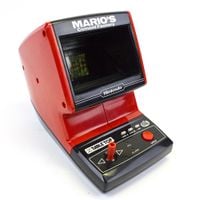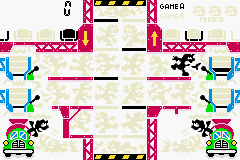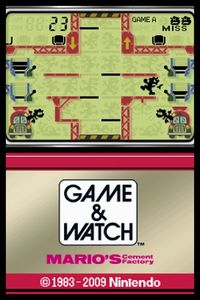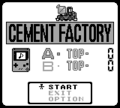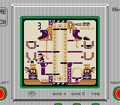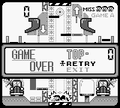Mario's Cement Factory: Difference between revisions
m (→Gallery) Tag: Mobile edit |
|||
| Line 90: | Line 90: | ||
==References in later games== | ==References in later games== | ||
*[[Super Smash Bros. (series)|''Super Smash Bros.'' series]]: [[Mr. Game & Watch]] has an attack that involves him grabbing opponents with a similar pose to how Mario grabs levers in this game. | *[[Super Smash Bros. (series)|''Super Smash Bros.'' series]]: [[Mr. Game & Watch]] has an attack that involves him grabbing opponents with a similar pose to how Mario grabs levers in this game. | ||
*''{{wikia|rhythm-heaven|Rhythm Heaven Fever}}'': Mr. Game & Watch appears in the Rhythm Game {{wikia|rhythm-heaven|Working Dough}}, posed similarly to lever-grabbing animation from this game. | *''{{wikia|rhythm-heaven|Rhythm Heaven Fever}}'': Mr. Game & Watch appears in the Rhythm Game {{wikia|rhythm-heaven|Working Dough}}, posed similarly to the lever-grabbing animation from this game. | ||
==Trivia== | ==Trivia== | ||
Revision as of 06:06, April 22, 2022
| Mario's Cement Factory | |||
|---|---|---|---|
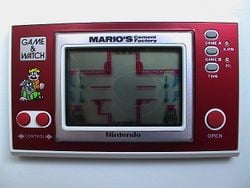
| |||
| Developer | Nintendo R&D 1 | ||
| Publisher | Nintendo | ||
| Platform(s) | Game & Watch, Mini Classics, Nintendo DSi, Nintendo 3DS | ||
| Genre | Puzzle/Platformer | ||
| Rating(s) |
| ||
| Mode(s) | Single player | ||
| Input | Game & Watch:
Nintendo 3DS:
| ||
Mario's Cement Factory is a Game & Watch game. Two versions of the game were produced: The first was for the Game & Watch Table Top released on April 28, 1983, and the second was a more conventional New Wide Screen Game & Watch that was released on June 16, 1983. Mario's Cement Factory was the first game in the Table Top series. The Table Top game resembles an arcade cabinet, and it is more colorful than the New Wide Screen game. In both versions, Mario's mission in the cement factory is to open doors to prevent cement containers from overflowing. To get to the different containers, Mario has to jump onto moving platforms. The New Wide Screen version was rereleased as a Mini Classics and is featured in the Gallery Corner in Game & Watch Gallery. It is also featured as a minigame in Game & Watch Gallery 4 with a Classic version and an updated "Modern" version.
The alarm indicator of the Table Top version is a bell that is located beside the upper lift section, and a driver rings the bell when the alarm goes off. In the New Wide Screen version, the alarm indicator is also a bell located beside the upper lift section, but the bell just swings when the alarm goes off.
Mario's Cement Factory also appears as one of the minigames in Game Boy Gallery, though it is simply called Cement Factory and features no Mario characters, and the playable character is the same unnamed character seen in the other minigames.
Gameplay
Classic version
There are two drivers, each in a truck under a container. Mario earns a point each time he empties a load of cement from the upper hopper and two points each time he empties a load from the lower hopper. Each container can hold only three loads of cement. Allowing the containers to overflow causes cement to spill down onto the workers, hurting them and giving Mario one miss. Falling off an elevator platform also earns a miss, as well as touching the very top of the screen and getting crushed by an elevator platform, or touching the very bottom and getting shocked by the floor of the elevator. In all versions of the game, there is an area on the lowermost portion of the elevator that Mario can use to save himself from touching the very bottom and getting shocked. On the Table Top version, there is a similar area on the uppermost portion of the elevator. This does not appear on any other version of the game. If Mario gets 300 points without any misses, the points will be worth double until he does get a miss. If he has any misses at said score, all misses will be cleared instead. When he receives three misses, the game is over.
Modern version
The Modern version of the game has Mario working in a cookie factory. Yoshi and Toad are featured instead of the drivers, with Yoshi eating the Yoshi Cookies made on the left conveyor belt and Toad packaging the Yoshi Cookies made on the right conveyor belt. Boos will also occasionally appear, taking up cookie dough slots on the second floor. Unlike in Classic Mode, however, Mario is allowed to fall down onto an elevator platform, but touching the very bottom or top still earns the player a miss. When Mario amasses 200, 500, and 700 points, a heart will appear for him to remove a miss. Music is also featured in this version, with the tempo changing depending on the speed of the game.
Selecting the game without starting it will also result in a humorous sequence being played. In particular, Yoshi and Toad are putting cookie batter on a conveyor belt each, only for Toad's batter to get stolen by a Boo, causing him to sob, and then the Boo, as a prank, drops the batter on Yoshi, with it being a large enough quantity that Yoshi is completely engulfed save for the eyes, while the Boo sticks out his tongue in a taunting manner as Yoshi is baffled at the entire situation.
Controls
 (left and right): Move
(left and right): Move and
and  : Open
: Open
DSiWare
Another port of the original version was released in August 2009 for DSiWare in Japan and March 2010 in America, Europe, and Australia. It is also available in the Nintendo 3DS eShop as DSiWare. In July–August 2012, to coincide with the release of New Super Mario Bros. 2, it was featured on the Mario folder in the main screen.
Gallery
Modern version
Game Boy Gallery (Cement Factory)
References in later games
- Super Smash Bros. series: Mr. Game & Watch has an attack that involves him grabbing opponents with a similar pose to how Mario grabs levers in this game.
- Template:Wikia: Mr. Game & Watch appears in the Rhythm Game Template:Wikia, posed similarly to the lever-grabbing animation from this game.
Trivia
- Early models[citation needed] of the Table Top version of Mario's Cement Factory used a slightly faster rearrangement of the first four seconds of "Another One Bites the Dust," a song released in 1980 by the British rock band Queen, for the game start jingle.
External links
- North American site
- Nintendo UK site
- Info page for the Table Top version of Mario's Cement Factory on In the Attic, a website dedicated to classic videogames.
- Info page for the New Wide Screen version of Mario's Cement Factory on In the Attic.
| Game & Watch games | ||
|---|---|---|
| Super Mario franchise | Donkey Kong (1982, MS) • Mario Bros. (1983, MS) • Mario's Cement Factory (1983, TT/NWS) • Mario's Bombs Away (1983, PS) • Donkey Kong Hockey (1984, MVS) • Super Mario Bros. (1986, CrS | 1987, Sp | 1988, NWS) • Mario the Juggler (1991, NWS) • Game & Watch: Super Mario Bros. (2020, CoS) | |
| Donkey Kong franchise | Donkey Kong (1982, MS) • Donkey Kong Jr. (1982, NWS | 1983, TT & PS) • Donkey Kong II (1983, MS) • Donkey Kong 3 (1984, MVS) • Donkey Kong Circus (1984, PS) • Donkey Kong Hockey (1984, MVS) | |
| Miscellaneous | Green House (1982, MS) | |
| MS: Multi Screen • TT: Table Top • PS: Panorama Screen • NWS: New Wide Screen • MVS: Micro VS. System • CrS: Crystal Screen • Sp: Special • CoS: Color Screen | ||
